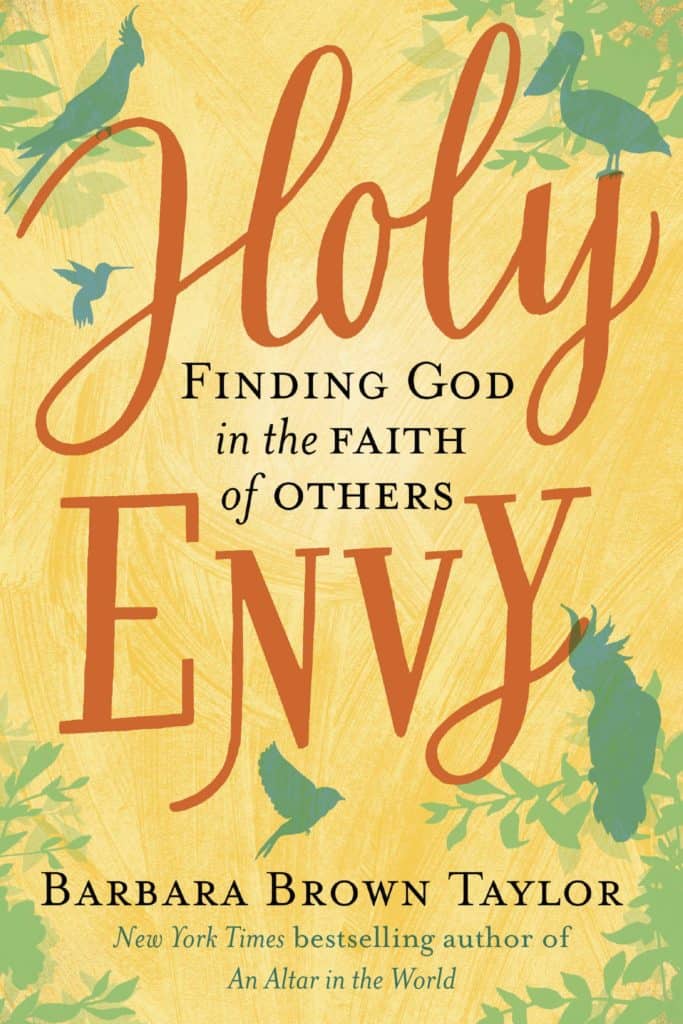
“God speaks, and God is to be heard, not only on Sinai, not only in my own heart, but in the voice of the stranger.” ~ Thomas Merton
Barbara Brown Taylor’s new book, Holy Envy (HarperCollins, 2019), documents what she discovers about God while teaching world religions to mostly white, culturally Christian undergrads in small-town Georgia (in a county that is home to exactly one movie theater and 62 churches). In a single semester she leads them on a breakneck expedition through Hinduism, Judaism, Buddhism, Islam, and, finally, Christianity (on which most of them fail the initial pop quiz). Of her Christian students she writes:
“Some are questioning whether the churches they grew up in have anything to offer them as they make their ways in a culture of many cultures with many views of truth, some of which make a great deal of sense to them. For those who counted on God to protect them from so many choices, it is as if the heavenly Father let go of their hand in a crowd one day and vanished into a sea of divine possibilities. I cannot protect the students in my classes from this any better than I can protect myself. Existential dizziness is one of the side effects of higher education, and it affects teachers too.”
“…it is as if the heavenly Father let go of their hand in a crowd one day and vanished into a sea of divine possibilities.”
I relished this book, devouring it slowly, returning to its most delicious bits over and over again, and thanking God for the author and her spiritual adventure with every nutritious bite. And as I sit down to write this, I’m very aware of a couple of things:
- A book review is every bit as subjective as the book being reviewed. My starting point of fascination for (almost) all things “other,” which accounts for my work facilitating conversation across deep difference among Christians, means I am predisposed to resonate with Taylor’s ideas. A dear friend of mine, on the other hand, a medical doctor who is drawn to clear boundaries and propositional truths, is suspicious of Taylor’s willingness to try on and snuggle up to ideas that lie outside Christian orthodoxy. There is no one I respect more than this friend—and I am strongly attracted to Taylor’s way of moving through a pluralistic world. I mention this because I think temperament plays a bigger role than most of us suspect when it comes to how we approach difference—especially, perhaps, theological difference. But my hope is to convince you that this book is worth a read regardless of your temperamental leanings.
- In my experience, so much theological diversity exists within the Christian family that “the church” can sometimes feel more like an interfaith setting than an intra-Christian one. I hope that even if you’re not the least bit interested in interfaith conversations, you’ll believe me when I say Taylor’s book has tremendous value in helping us navigate those family discussions, which is perhaps where we should all start. Charity, as they say, begins at home.
The title Holy Envy is borrowed from biblical scholar Krister Stendahl’s proposed rules for inter-religious understanding:
- When trying to understand another religion, you should ask the adherents of that religion and not its enemies.
- Don’t compare your best to their worst.
- Leave room for holy envy.
Regarding this last point, every religion, as Taylor puts it, “is more than a source of conflict or a calculated way to stay out of hell.” They are “treasure chests of stories, songs, rituals, and ways of life” that have much to teach us. She invites us to peek into those treasure chests that are least familiar to us, at the risk of both disruption and revelation. We’ve got much to gain from such an endeavor, and a few things that we would benefit by losing. As Stendahl also said, “In the eyes of God, we are all minorities. That’s a rude awakening for many Christians, who have never come to grips with the pluralism of the world.”
I recently learned that an interfaith group in my city was taking turns visiting each other’s places of worship. It was meant to facilitate cultural exchange, a chance for each person to experience the faith traditions of others. But the organizer noticed that people were more willing to host than to be hosted, and this revealed a fundamental imbalance: We want people to be curious about and accepting of our faith tradition, but we are often less than curious and accepting of theirs. What would happen if we changed that, if we moved towards the “other” with genuine, compassionate curiosity and a hunger to learn? What if we offered our hosts the gift of hospitality that is inherent in being a good guest?
While Taylor shares tales of awkward and fascinating field trips to mosques and temples and synagogues, of her students’ struggles to grasp the fundamentals of different faiths as well as to articulate the tenets of their own, the underlying current of the book is personal: it is the author’s own journey to better understand and embody her Christian faith—to be, in fact, “born again.” She writes:
“One of the greatest gifts that holy envy has given me is the ability to reimagine my own tradition. I would like to tell you that it is the product of gaining wisdom, insight, and perspective through the study of other religions, but that would not be true. Instead, it is the product of losing my way, doubting my convictions, interrogating my religious language, and tossing many of my favorite accessories overboard when the air started leaking out of my theological life raft. Only then was I scared and disoriented enough to see something new when I looked back at my old landmarks, many of which I was approaching from an unfamiliar angle.”
In sharing her journey, Taylor invites us, too, to venture into the fear and disorientation of submitting our beliefs to the gaze of the other, of daring to look at ourselves through the lens of different religions—and herein lies the greatest gift of her book. She flips Stendahl’s second rule—“Don’t compare your best to their worst”—and risks comparing the best of other religions, which she approaches with theological hospitality, to the worst of her own, which she believes results in her becoming a better Christian. She laments that so much of the American church focuses on Christian belief, to the detriment of Christian practice, and urges us to ask more demanding and perhaps interesting questions of ourselves: How does being a Christian change the way you live? What’s the hardest part about loving your neighbor as yourself? Paying attention to orthopraxy over orthodoxy, for a change, will reveal the chasm between our dogma and our deeds—a painful but useful exercise.
One of Taylor’s most appealing qualities is her willingness to submit herself to the same scrutiny to which she subjects her fellow Christians. She confesses that as a person of privilege she is often hamstrung by her own experience of the world; she admits to confirmation bias and to constructing her own divine mosaic. “Whether the resources at my disposal come only from my own tradition or from a wide array of traditions, my ego stays very active selecting the ones that please me most. So how is this any different from the gospel cherry-picking that drives me crazy when I see members of my own religion doing it?” She doesn’t pretend to be a guide for anyone else, and she’s honest about the ankle-twisting turns and vision-limiting headgear of her personal hike through the spiritual wilderness.
I’d like to see us learn to hold our convictions with a more open hand and offer each other grace, patience, and the gift of fascination with how our denominational counterparts experience God.
But if you’re willing to accompany Taylor on her journey, I predict you’ll take home one or more of the following souvenirs:
- An enlarged inner landscape and more generous view of those outside the Christian faith;
- An unflinching look at how we ask others to represent their entire religion while insisting on distancing ourselves from our own faith’s worst elements;
- A reminder of the “disproportionate number of famous Bible stories about Jesus [that] involve religious strangers … people who worshipped other gods or worshipped the same one he did in an unorthodox way,” and who remind us that God is all about opening up to the stranger among us;
- The exhilarating if unsettling experience of observing and flexing with God’s Spirit;
- An invitation to “shatter [your] custom-made divine mosaic” (we all have one) by accepting that our “fundamentally irritating and sometimes frightening” human siblings are also made in the image of God.
I believe that Taylor’s story offers a much-needed challenge to contemporary American evangelicalism, where we too often draw dividing lines rather than drawing in—or better yet going out to meet—those who are different from us. I’d love to see us start by treating our brothers and sisters in Christ with the kind of charity and hospitality with which Taylor approaches people of other faiths. I’d like to see us learn to hold our convictions with a more open hand and offer each other grace, patience, and the gift of fascination with how our denominational counterparts experience God.
For surely if Christians can learn to live with and love those “strange, funny, compelling, complicated human beings” who are also members of Christ’s body, we might have a leg to stand on when we say that Jesus reconciles “to himself all things…by making peace through his blood, shed on the cross” (Colossians 1:20).
Kristyn Komarnicki is director of dialogue and convening for Christians for Social Action. She leads the Oriented to Love dialogue program, helping diverse Christians build unity that is deeper than agreement.
is director of dialogue and convening for Christians for Social Action. She leads the Oriented to Love dialogue program, helping diverse Christians build unity that is deeper than agreement.


One Response
Kristyn, Thank you so much for this heads up! I, too, really enjoy the stirrings of BB Taylor!!